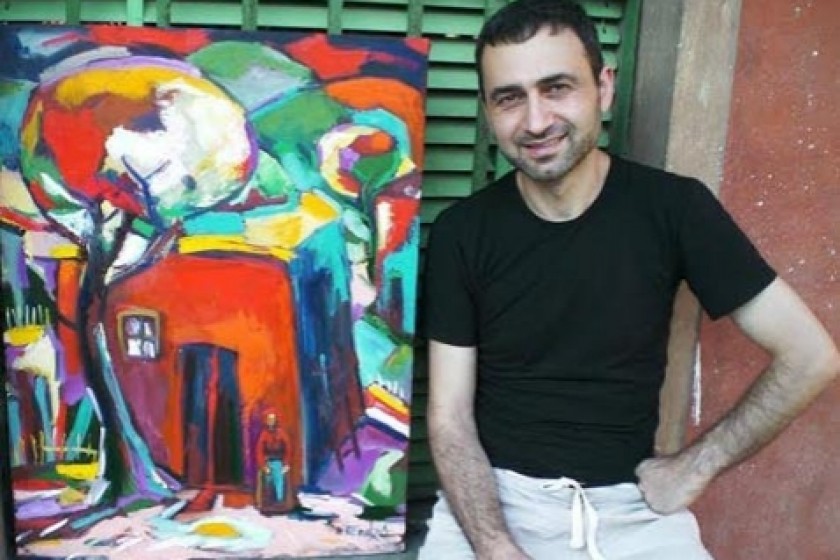
The Artist Known as "Untza": 'I Play with the Colors of My Childhood'
Painter and sculptor Gevorg Babakhanyan, who goes by the name of Untza (gift, present) speaks to Hetq about his art and its sources.
How are your paintings born? Are they flashes going off in your head, or are they reflections of people you have met in life and of images of nature?
There is an opinion that an artist is a mirror of nature. This is truly the case. Sure, there is the reflection of life within you, but what is important is the kind of mirror you are. From where does the source that nourishes your soul come from? For example, the source that nourishes me comes from my childhood. A person can type any ideology and shape it to serve as the basis of their art. Mine is my childhood. That’s why it is sincere and why people are attracted to my paintings.
For isn’t it true that we derive from our childhood, and that the best things are found within it? This is why I always want to clean that mirror with the brush of my childhood. Like a child plays in the yard, I play with my paints. I do not paint. I play with paints embued with the colors of my childhood. Simply that.
Is there one work you’ve done with the brush that really speaks to you and which you’d like to point out?
You mean like the La Giaconda was for Leonardo? I don’t have one such work, but there is the individual that is in all my paintings. It’s the child, who is in my paintings. That is dear to me.
Do you receive commissions from people to paint this or that? What’s your attitude to the commercial side of art? Can a commissioned work be as convincing and alive as one that isn’t?
In general, I try to avoid commissions. I’ve only done a few. But if we take into account that many of the works of Michelangelo and others were commissions, it’s clear that even commissioned works can become powerful art works. Of course, if that’s what you like. It isn’t important what you do, but rather how you do it.
To humiliate the masterful sculptor Gian Lorenzo Bernini, the French king commissioned that he sculpt a hermaphrodite. The result was a masterpiece. It’s now on display at the Louvre. So, whether it’s a commission or not isn’t important, but rather how you create that work.
There’s the belief that each blank sheet of paper or canvas has a preserved image within it and that the sole mission of the artist is to draw that image out. Do you agree?
Paper is a material for me. They say that the world was created after the eruption of a volcano or other such manifestation. I constantly ask myself how a spiritual being can be born from objects that have no spirit.
It’s beyond the bounds of logic. In other words, it’s proof that there is a God. In the same manner, there cannot be a spirit or soul hidden in a spiritless piece of canvas. The spirit is within you.
Are there people whom you consider to be your teachers?
I’ve always realized that there are no instructors but simply people who want to learn. And if one wants to learn, everything and everyone can become you teacher; even an ant. Our artists can also be teachers, or more correctly put, prompters. The great artists are prompters. If you want to listen, you can learn much from their works. For me there is Leonardo da Vinci, and then other painters. This is how I separate them.
How does the surrounding environment influence your spiritual makeup? Is the socio-economic situation in Armenia in any way reflected in your work?
Leonid Yengibaryan once said that we are all responsible for what transpires around us. Of course, what is taking place in Armenia does influence me. But my friends always tell me to stay away from all that. There is an ideal situation to be in, like a ship on the ocean. You are on the water but the water isn’t in you.
One must be engaged in this life – to listen, learn and participate. As a citizen you must be involved in all that, but you shouldn’t carry it within you. Once you do it destroys you, just like a ship that fills with water. It sinks.
I love my country very much. Sure, there are problems but they’ll be fixed. Not everything comes from above. We must cleanse ourselves from the bottom up.
Patriotism for me isn’t hating the Turks but rather to hold on to this country. Don’t litter the streets. You’ll be a patriot for doing so. Otherwise, we are involved in a cheap and convenient type of patriotism.
We seem to love Sassoun and Moush more than the Armenia of today. That other Armenia, that Sassoun and Moush, do not need our attention and embrace. We merely need to love it from afar, to love it once a year on April 24. It’s the Armenia of today that we need to care for and embrace.
Interview conducted by Marineh Barseghyan
 Videos
Videos Photos
Photos




Comments (3)
Write a comment